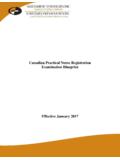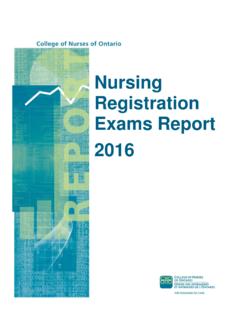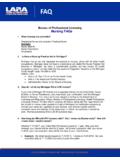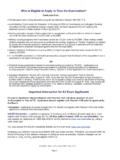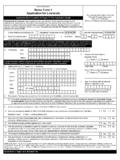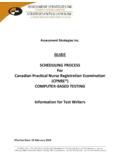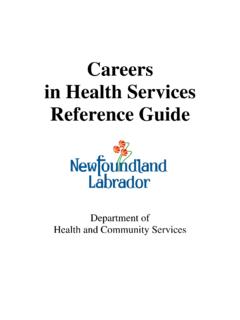Transcription of Canadian Practical Nurse Registration Examination …
1 Oooooooo Canadian Practical Nurse Registration Examination Blueprint Effective January 2012 Developed by Assessment Strategies Inc., Canada s Testing Company. All rights reserved. No part of this document may be reproduced, stored in a retrieval system, or transcribed, in any form or by any means, electronic, mechanical, photocopying, recording, or otherwise, without written permission of the publisher. Assessment Strategies Inc., Canada s Testing Company 1400 Blair Place, Suite 210 Ottawa ON K1J 9B8 Tel: 613-237-0241 or 1-888-900-0005 Fax: 613-237-6684 E-mail: CPNRE web site: Corporate web site: Assessment Strategies Inc., Canada s Testing Company would like to thank the members of the CPNRE Competency and Blueprint Committee and the Client Advisory Group for their contribution to the development of this document. CPNRE Competency Review Committee Teresa Bateman Alberta Janice Harvey British Columbia Pat VanWoensel Manitoba Wayne Brown New Brunswick Janice O Neill Newfoundland and Labrador Judy Morrow Nova Scotia Sandra Brewer Ontario Dawn Rix-Moore Prince Edward Island Roni Clubb Saskatchewan CPNRE Client Advisory Group Linda Stanger Alberta Elaine Baxter British Columbia Pat MacDonald Manitoba Kevin Symes New Brunswick Paul Fisher Newfoundland and Labrador E.
2 Jeanne Gagnon Northwest Territories Ann Mann Nova Scotia Kathie Conlin-Saindon Ontario Alana Essery Prince Edward Island Colin Hein Saskatchewan Ruth Koenig Yukon i TABLE OF CONTENTS PREFACE .. iii INTRODUCTION ..1 UNDERSTANDING COMPETENCIES ..2 TECHNICAL SPECIFICATIONS ..3 1. Developing the Set of Competencies .. 3 2. Assumptions .. 4 3. Competency Framework .. 5 4. Sampling of Competencies by Importance .. 6 GUIDELINES ..7 Structural Variables .. 7 1. Examination Length and Format .. 7 2. Setting the Standard .. 7 3. Test Equating .. 7 4. Question Presentation .. 8 5. Cognitive Levels .. 8 Contextual Variables .. 9 1. Client type .. 9 2. Client age .. 9 3. Client diversity .. 9 4. Work environment .. 9 CONCLUSION ..10 GLOSSARY ..11 APPENDIX A: REGULATORY AUTHORITIES ..16 APPENDIX B: DEVELOPMENT AND ADMINISTRATION ..18 APPENDIX C: LIST OF COMPETENCIES ..20 APPENDIX D: SUMMARY CHART GUIDELINES ..26 ii LIST OF TABLES Table 1. CPNRE weightings by competency framework category.
3 5 Table 2. Competency groupings for the CPNRE .. 6 Table 3. Distribution of questions by cognitive level .. 8 Table 4. Distribution of client age .. 9 LIST OF FIGURES Figure 1. Competencies assessed by the CPNRE.. 2 iii PREFACE Assessment Strategies Inc. (ASI), Canada s Testing Company, is pleased to present the Canadian Practical Nurse Registration Examination Blueprint (2011).1 Beginning in January 2012, this document replaces the previous document entitled Blueprint for the Canadian Practical Nurse Registration Examination (2007). The need for a new Blueprint arose from a comprehensive review of entry-level competencies required of Practical nurses beginning to practise in the year 2012. Administration of the first Examination developed from the new Blueprint is targeted for January 2012. For examinations administered before this date, the 2007 edition of the Blueprint applies. The Blueprint was developed by the Canadian Practical Nurse Registration Examination (CPNRE) Competency and Blueprint Committee.
4 This group was comprised of representatives from provincial/territorial regulatory authorities that administer the Examination , as well as from the areas of practice and education. This committee created the Blueprint to guide those involved in the development of the Canadian Practical Nurse Registration Examination and to provide the public with Practical information about the CPNRE. The decisions of the committee were guided by the competencies, definitions, assumptions and results of a national validation survey. ASI wishes to thank all the Practical nurses and other health-care professionals who have contributed to the creation of this Blueprint. In particular, thanks are extended to the following: the regulatory authorities; the CPNRE Competency and Blueprint Committee; the Practical nurses, educators and administrators of Practical nurses across Canada who responded to the competency validation survey; the CPNRE Examination Committee; and, finally, the Client Advisory Group for the CPNRE.
5 As part of the process to ensure the continued validity of the CPNRE, a comprehensive review of the Canadian Practical Nurse Registration Examination Blueprint (2012) is planned for 2014. In addition, the Blueprint will be evaluated annually to reaffirm that the competencies and the guidelines for Examination development continue to reflect what is expected of an entry-level Practical Nurse . ASI encourages all users of this document to provide feedback that may be useful in future revisions of the Blueprint. Please forward all such comments to the address presented on the inside cover of this document. 1 The term Practical Nurse used in this document refers to licensed Practical Nurse and registered Practical Nurse . iv Effective 2012 - 2016 1 August 2010 INTRODUCTION Each province and territory is responsible for ensuring that graduates of Practical nursing programs in Canada and Practical nurses educated in other countries applying for licensure/ Registration as a Practical Nurse meet an acceptable level of competence before they begin to practise.
6 This level of competence is measured, in part, by the Canadian Practical Nurse Registration Examination (CPNRE) administered by the provincial and territorial regulatory authorities (see Appendix A for contact information). Assessment Strategies Inc. (ASI) produces the CPNRE by working in collaboration with Practical nurses as well as educators and administrators of Practical nurses from across Canada who serve as the content experts in developing and validating the CPNRE on behalf of the regulatory authorities. An overview of the development and administration process for the CPNRE is presented in Appendix B. The complexity of this process reflects that Registration examinations have a well-defined purpose: to protect the public by ensuring that professionals possess sufficient knowledge and skills to perform important occupational activities safely and effectively. In the case of the CPNRE, the purpose of the Examination is to protect the public by ensuring that the entry-level Practical Nurse possesses the competencies required to practise safely and effectively.
7 The primary function of the Canadian Practical Nurse Registration Examination Blueprint is to describe how the Examination is to be developed. Specifically, the Blueprint provides explicit instructions and guidelines on how the competencies ( , the integrated knowledge, skills, behaviour and clinical judgment expected of an entry-level Practical Nurse in order to provide safe, competent and ethical care) are to be expressed within the Examination in order for accurate decisions to be made on the candidates readiness to practise safely and effectively. Prior to producing this Blueprint, ASI conducted an extensive study to identify the competencies required for the safe and effective practice of entry-level Practical nurses in Canada. Provincial and territorial regulatory authorities were active participants in all phases of the investigation, which served to identify and validate a comprehensive set of competencies expected of the entry-level Practical Nurse . With this set of competencies and the validation data, the essential components of the CPNRE were assembled.
8 Because of ongoing changes that occur in the Practical nursing profession, a validation study of the competencies is conducted at least every five years. By periodically conducting a comprehensive review of the competencies measured by the CPNRE, ASI is able to maintain the validity of the Examination and ensure that it is psychometrically sound and legally defensible. In addition to the periodic comprehensive review and validation study, the competencies are reviewed and evaluated annually by content experts. Canadian Practical Nurse Registration Examination Blueprint 2 UNDERSTANDING COMPETENCIES A fundamental component of a formal approach to Examination development is a thorough description of the content domain being measured. In the case of the CPNRE, the content domain of interest consists of the competencies an entry-level Practical Nurse is required to possess in order to practise safely and effectively. The CPNRE competencies found in this Blueprint have the primary purpose of defining the content domain for the Examination .
9 Users of the Blueprint should recognize that the competencies are not intended to supersede or replace competency lists or standards of practice for Practical nurses that have been established by regulatory authorities throughout Canada. In fact, the CPNRE competencies are designed to represent only a subset of the competencies required by the regulatory authorities. To illustrate this point, Figure 1 presents the full complement of competencies required of Practical nurses as the shaded area within the rectangle. The rectangle, of course, is broader than the first enclosed circle, which represents the complement of entry-level competencies expected upon successful completion of a Practical Nurse education program. This is to be expected, as graduates will continue to expand their knowledge, skills, behaviours and clinical judgment with acquired experience. The innermost circle represents the entry-level competencies related to safe and effective practice that are common across the Canadian jurisdictions and that can be measured on a multiple-choice Examination .
10 Competencies that are unique to some provinces or territories are not assessed by the CPNRE nor are competencies unsuitable for multiple-choice questions. As a result, the circle representing the competencies assessed by the Examination is smaller than the circle representing entry-level competencies Figure 1. Competencies assessed by the CPNRE. Competencies for Practice as a Practical Nurse Entry-level Competencies Competencies Assessed by the CPNRE Effective 2012 - 2016 3 August 2010 TECHNICAL SPECIFICATIONS COMPETENCIES The foundation to the Examination development process is a thorough description of the competencies an entry-level Practical Nurse is required to possess in order to practise safely and effectively. The process to develop the competencies for the CPNRE is presented below. 1. Developing the Set of Competencies Initial Competency Review As a starting point for developing the set of competencies, the CPNRE Competency and Blueprint Committee was formed with representation from the regulatory authorities for Practical nurses in Canada that use the CPNRE.
